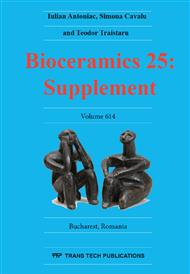p.168
p.173
p.178
p.183
p.190
p.196
p.200
p.206
p.212
Experimental Evaluation on Rat Model of Different Bioresorbable Materials Potentially Used as Orthopedic Biomaterials
Abstract:
This study aims to present the preliminary studies related to the evaluation of the in vivo biocompatibility using the rat model of bioresorbable composite materials type collagen-tricalciumphophate and colagen-tricalcium phosphate-magnesium for potentially medical application in trauma surgery. These biomaterials could be used as short-term structural support for bone tissue defects and can be reabsorbed into the body after healing are being sought. For in-vivo evaluation of bioresorbable materials on 2 groups of twenty Wistar and brown Norway rats for a period of 18 months. We simulated tissue defects in different anatomical areas of the animals and these two types of biomaterials were implanted. The animals were evaluated periodically with clinical exams, laboratory tests (blood tests, histopatological tests, radiological control) and anatomical dissection for macroscopic examination of the tissues. After different times (3, 6 and18 months) of implantation we sacrificed the animals. We observed the resorbtion rate of the biomaterials into the tissues in conjunction with tissue regeneration. We also note the inflammatory response and foreign body reactions into the adjacent tissue, using histopathological examinations. Due to the reaction of the materials in contact with the bone narrow a layer of magnesium calcium phosphate was formed which contributes to the local tissue healing. Our preliminary investigation results on these materials demonstrate that all the implanted materials were absorbed in vivo without any pathological changes in the rat body. Other future researches will be made in order to validate these biomaterials as orthopedic biomaterials useful in bone defects regeneration.
Info:
Periodical:
Pages:
196-199
Citation:
Online since:
June 2014
Authors:
Keywords:
Price:
Сopyright:
© 2014 Trans Tech Publications Ltd. All Rights Reserved
Share:
Citation:


